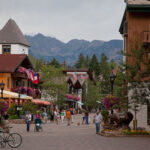Get to know more about the life on Earth, from plants to reptiles with any of the great courses at CU this year. Not only can you find out how to study biology, but Teaching Biology will help you educate others in biology. Listed below are the coolest of this extremely cool program at CU.
What is Ecology and Evolutionary Biology?
Ecology is the scientific study of the distribution and abundance of living organisms and how the distribution and abundance are affected by interactions between the organisms and their environment. The environment of an organism includes both physical properties, which can be described as the sum of local abiotic factors such as insolation (sunlight), climate, and geology, and biotic factors, which are other organisms that share its habitat.
Evolutionary biology is a sub-field of biology concerned with the origin and descent of species, as well as their change, multiplication, and diversity over time. One who studies evolutionary biology is known as an evolutionary biologist, or less formally, an evolutionist.
Evolutionary biology is an interdisciplinary field because it includes scientists from a wide range of both field and lab oriented disciplines. For example, it generally includes scientists who may have a specialist training in particular organisms such as mammalogy, ornithology, or herpetology, but use those organisms as case studies to answer general questions in evolution. It also generally includes paleontologists and geologists who use fossils to answer questions about the tempo and mode of evolution, as well as theoreticians in areas such as population genetics and evolutionary psychology. In the 1990s, developmental biology made a re-entry into evolutionary biology from its initial exclusion from the modern synthesis through the study of evolutionary developmental biology.
Coolest courses in Ecology and Evolutionary Biology
EBIO 1030: Biology: A Human Approach 1 (3 Credits) – You will study the principles of biology and their implications. The central theme for this class is humans and the environment, emphasizing ecology, natural resource conservation, and the interrelatedness of a growing human population. This course is recommended for nonscience majors.
EBIO 1210: General Biology 1 (3 Credits) – This class provides students with a concentrated introduction to molecular, cellular, genetic, and evolutionary biology. General Biology 1 focuses on fundamental principles, concepts, facts, and questions. Intended for science majors.
EBIO 2010: Environmental Issues and Biology (1 to 3 Credits) – Find out how the natural environment is currently stressed by a variety of human actions. The course examines the nature of these environmental problems and their impact on living organisms, both human and nonhuman species.
EBIO 2040: Principles of Ecology (4 Credits) – This class will introduce students to the principles of ecology, emphasizing patterns and processes at various levels of biological organization. The scope of this course is global, but there are examples in local environment too. The laboratory focuses on techniques in field biology.
EBIO 2070: Genetics: Molecules to Populations (4 Credits) – Principles of genetics and developmental biology at levels of molecules are covered in this class. Also covered in this course are such topics as cellular organelles, individuals, and populations. Study asexual and sexual life cycles; and heredity. Recitations allow discussion of genetics problems and implications of genetic principles, and provide demonstrations and simulations of genetic processes.
EBIO 2590: Plants and Society (2 Credits) – Acquaints students with the plants that are both essential and desirable to human survival, well-being, and quality of life. Plants and world cultures, and food plants are among the topics covered in this class. Find out all there is to know about commercial products; such as, beverages, extracts, herbs, and spices. Given my previous work on herbs, you might say that this course is right up my alley.
EBIO 3010: Teaching Biology (1 to 2 Credits) – Provides an opportunity to assist in teaching of specific laboratory section in EBIO under direct faculty supervision. Students must make arrangements with the faculty member responsible for the course in which they plan to assist. May be repeated up to 4 total credit hours.
EBIO 3080: Evolutionary Biology (4 Credits) – This class focuses on the fundamental evolutionary concepts that provide explanations for the diversification of life on Earth. Specific topics in Evolutionary Biology include the evidence for evolution, adaptation by natural selection, speciation, systematics, molecular and genome evolution, and macroevolutionary patterns and processes.
EBIO 3110: Population and Community Ecology (3 Credits) – Students are presented with the principles of ecology that relate to the niche, population growth, metapopulations, population interactions (within and between trophic levels), community structure and development, landscape ecology and species diversity.
EBIO 3170: Arctic and Alpine Ecology (3 to 4 Credits) – Discover the biology of arctic and alpine environments, limiting physical factors (such as geomorphology and climatic history), and human interaction with cold-stressed environments, especially the arctic in this cool class – no pun intended.
EBIO 3190: Tropical Marine Ecology (3 Credits) – You will learn about the biology and ecology of marine ecosystems, emphasizing those occurring in tropical regions such as coral reefs. Students will study how these ecosystems are changing and the future impact of human stress on the marine environment.
EBIO 3240: Animal Behavior (4 Credits) – Basic concepts and history, methods of study, ethical issues, neurobiology, behavior, and the development of behavior are among the topics you can find in this class. Learn about predator-prey relationships, communication, aggression and dominance, mating systems, cognitive ethology, and parental care. When possible, life-history strategies, the evolution of behavior, and behavioral ecology are stressed.
EBIO 3400: Microbiology (4 Credits) – This class examines distinguishing characteristics of microorganisms based on structural-functional relationships, taxonomy, growth, and physical-chemical agents of control including antibiotics, metabolism, and genetics. You will be introduced to applied microbiology emphasizing infectious diseases, basic concepts of immunology, and microbial ecology.
EBIO 3770: Animal Diversity: Vertebrates (4 Credits) – This course provides a broad overview of the biology of vertebrates: evolution and systematics, morphology, physiology, behavior, ecology, and biogeography. The labs focus on the diversity of vertebrates, including adaptations and diagnostic features of major groups.
EBIO 3940: Argument in Scientific Writing (3 Credits) – Argumentative strategies used in scientific writing is the focus of this course. You will be reviewing essential writing skills to prepare students for academic and professional communication. This course is restricted to juniors and seniors.
EBIO 4030: Limnology (3 Credits) – An intriguing course that examines the ecology of inland waters, including a detailed consideration of physical, chemical, and biological properties of freshwater ecosystems: origins and major characteristics of lakes and streams, survey of chemical and nutrient cycles in freshwater habitats, and survey of biotic composition of freshwater environments. Discover important themes in modern freshwater ecology are considered, including energy flow, trophic structure, eutrophication, and management of freshwater ecosystems.
EBIO 4090: Coral Reef Ecology (2 Credits) – This class includes one week of lectures in Boulder and one week of field studies on the Caribbean reefs at Cozumel, Mexico, one of the most complex and beautiful ecosystems in the world. This will be a two week, fall-semester course beginning after Christmas.
EBIO 4140: Plant Ecology (3 Credits) – Learn all there is to know about the relationships between plants and their physical and biological environments, encompassing physiology, competition, plant-soil and plant-animal interactions, population dynamics, diversity, and influence on ecosystem function.
EBIO 4150: Techniques in Ecology (1 to 2 Credits) – Become an authority on the application of modern ecological techniques; such as, stream biology, aquatic biology, environmental measurement and control, and techniques in geoecology.
EBIO 4160: Introduction to Biochemistry (3 Credits) – This course covers fundamentals of biogeochemical cycling, emphasizing water, carbon, and nutrient dynamics in terrestrial ecosystems. Also, you’ll get an education in chemical interactions of atmosphere, biosphere, lithosphere, and hydrosphere; and natural and human-managed environments.
EBIO 4660: Insect Biology (4 Credits) – Students will introduced to evolution, ecology, physiology, and behavior of insects. The class focuses on how insects have solved problems, such as maintaining water balance or finding food, that are shared by all animals but for which there may be unique solutions among the insects. Agricultural and human health problems relative to entomology are discussed.
EBIO 4740: Biology of Amphibians and Reptiles (3 Credits) – Comparative morphology, taxonomy, ecology, behavior, and geographic distribution of amphibians and reptiles is the focus of this class. You’ll be using animals and animal tissue.
EBIO 4760: Mammalogy (4 Credits) – Learn all there is to know about the origin, evolution and adaptation, geographic distribution, ecology, and taxonomy of mammals. You’ll get a field and laboratory study of Coloradan species.
About the university or college
Little known facts: The school was established back in 1876. Their motto is “Let Your Light Shine”. There have been approximately 24,000 undergraduates and 4,000 post-graduates. They were the first to create a new form of matter, called the “Bose-Einstein condensate” which is a few hundred billionths of a degree above absolute zero. They were the first to observe a “fermionic condensate” formed from pairs of atoms in a gas. They discovered a protein in the blood that can prevent the AIDS virus from reproducing and spreading to healthy cells. The university has also accomplished many more things; such as, the creation of a classifying and numbering system for human chromosomes, and the production of computerized 3D images of the entire body in anatomical sections.
University or college location: Boulder, Colorado
Directions to the college or university
From DIA: You will fly in or out of DIA or should I say, Denver International Airport. Driving time between DIA and Boulder is approximately 60 to 90 minutes. From DIA, follow Peña Boulevard (10 miles) south to I-70, and exit onto I-70 west. Follow I-70 west to I-270 west. I-270 merges into U.S. 36 west and takes you west into Boulder (about 23 miles). Exit at Baseline Road; turn left on Broadway and turn right or north. The campus is to the right. For alternate routes, see the map from DIA to Boulder.
From the Denver Area and South: To get to Boulder from the Denver area, go west on U.S. 36 (from I-25 or I-270) and exit at Baseline Road. Turn left (west) on Baseline Road, then right or north on Broadway to campus.
From the North: From the north, take U.S. 287 south to Highway 119. Highway 119 becomes Highway 157 (Foothills Parkway) just north of Boulder. Turn right or west from Foothills Parkway onto Baseline Road. Drive west on Baseline to Broadway, then turn right (north) on Broadway to campus.
From the West: Take I-70 east to U.S. 6. Go east on U.S. 6 to CO. 58. Turn right (east) on CO.58 to CO. 93. Make a left (north) onto CO. 93 towards Boulder. CO. 93 will turn into Broadway once in Boulder. Continue on Broadway west until you see the campus on your right. It will be shortly after you pass Baseline Rd.




